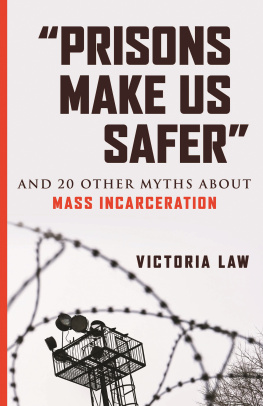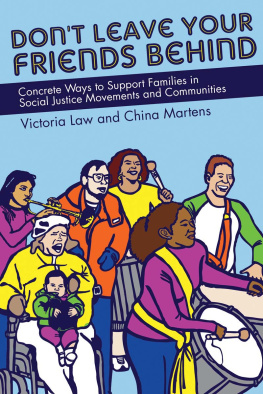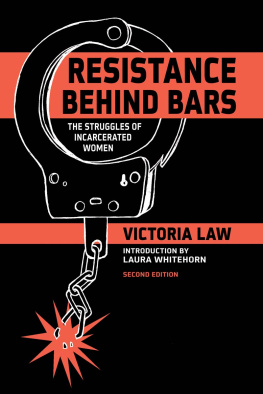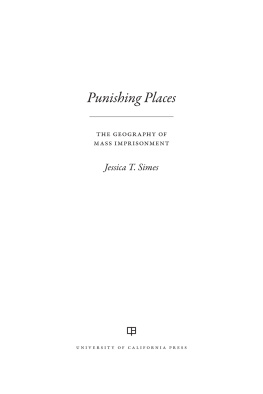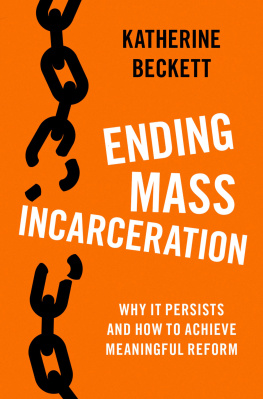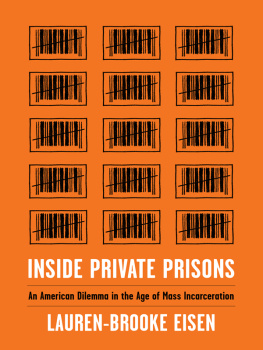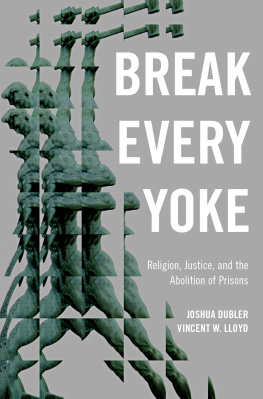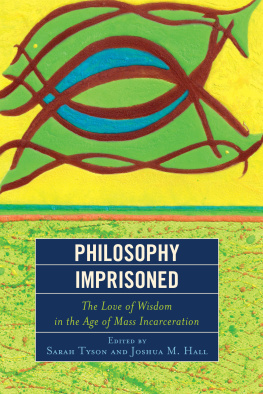Victoria Law - Prisons Make Us Safer: And 20 Other Myths about Mass Incarceration
Here you can read online Victoria Law - Prisons Make Us Safer: And 20 Other Myths about Mass Incarceration full text of the book (entire story) in english for free. Download pdf and epub, get meaning, cover and reviews about this ebook. year: 2021, publisher: Beacon Press, genre: Politics. Description of the work, (preface) as well as reviews are available. Best literature library LitArk.com created for fans of good reading and offers a wide selection of genres:
Romance novel
Science fiction
Adventure
Detective
Science
History
Home and family
Prose
Art
Politics
Computer
Non-fiction
Religion
Business
Children
Humor
Choose a favorite category and find really read worthwhile books. Enjoy immersion in the world of imagination, feel the emotions of the characters or learn something new for yourself, make an fascinating discovery.
- Book:Prisons Make Us Safer: And 20 Other Myths about Mass Incarceration
- Author:
- Publisher:Beacon Press
- Genre:
- Year:2021
- Rating:3 / 5
- Favourites:Add to favourites
- Your mark:
- 60
- 1
- 2
- 3
- 4
- 5
Prisons Make Us Safer: And 20 Other Myths about Mass Incarceration: summary, description and annotation
We offer to read an annotation, description, summary or preface (depends on what the author of the book "Prisons Make Us Safer: And 20 Other Myths about Mass Incarceration" wrote himself). If you haven't found the necessary information about the book — write in the comments, we will try to find it.
Victoria Law: author's other books
Who wrote Prisons Make Us Safer: And 20 Other Myths about Mass Incarceration? Find out the surname, the name of the author of the book and a list of all author's works by series.
Prisons Make Us Safer: And 20 Other Myths about Mass Incarceration — read online for free the complete book (whole text) full work
Below is the text of the book, divided by pages. System saving the place of the last page read, allows you to conveniently read the book "Prisons Make Us Safer: And 20 Other Myths about Mass Incarceration" online for free, without having to search again every time where you left off. Put a bookmark, and you can go to the page where you finished reading at any time.
Font size:
Interval:
Bookmark:


I frequently use the term jails and prisons when describing the incarceration of people who have lost their liberty. However, jails and prisons serve two different purposes in the criminal court system: Jails are used to detain people while they are awaiting trial; they are also used for people sentenced to less than twelve or, in some states, eighteen months behind bars. Prisons are used to incarcerate people who have been convicted or pleaded guilty and who have been sentenced to more than one year behind bars.
The term criminal justice system refers to the legal system in which people are arrested, prosecuted, and threatened with imprisonment. Advocates, particularly abolitionists, are increasingly rejecting the use of that term, noting that the system does not provide justice; it metes out punishment. They often use the terms criminal legal system or criminal punishment system instead. In most instances, Ive chosen to use the term criminal legalrather than the less accurate but more widely used criminal justiceto describe the system. I keep the term criminal justice reform to indicate the discussions and promises made by politicians and political candidates.
Throughout this book, I have avoided using the terms that are often used to describe people who are incarcerated inmates, prisoners, convicts, and felons unless Im referring to a historical term (such as county convict). Eddie Ellis, a former Black Panther who spent twenty-three years in prison and then founded the Center for NuLeadership on Urban Solutions, pointed out that these terms are devoid of humanness which identify us as things rather than as people. Ive eschewed these terms in an effort to emphasize that no matter why someone is incarcerated, each of the 2.3 million people behind bars are, first and foremost, human beings.
T he United States incarcerates significantly more of its residents than any other nation. Though it has only 5 percent of the worlds population, with 2.2 million people in jails and prisons, it has nearly 25 percent of the worlds prisoners. As shocking as it is, for years, society remained largely silent about the massive increases of people being locked away and about the abhorrent conditions inside jails and prisons.
Thats beginning to change. In recent years, mass incarceration has become a frequent topic of news headlines, political debates, and even pop culture. Bolstered by shows like Orange Is the New Black, documentaries like Ava DuVernays 13th and When They See Us, Bryan Stevensons memoir-turned-biopic Just Mercy, and Michelle Alexanders best-seller The New Jim Crow, prison issues are no longer relegated to the political sidelines.
The prison population hasnt always been so massive. In 1980 the United States held 501,886 people behind bars. But a combination of tough on crime policies and the publics demand for longer and harsher punishments increased the number of people behind bars by a whopping 500 percent over the past forty years to todays 2.2 million incarcerated people. If you add in the number of people on probation or parole, that number rises to nearly seven million (from 1.84 million in 1980).
For women, those numbers rose even more dramatically. Between 1980 and 2014, the number of women behind bars increased 800 percent from 26,378 to 215,332. This increase, as distressing as it is, does not include the additional one million women on probation or parole; nor does it include the unknown number of trans women held in mens jails and prisons.
As of 2018, 698 of every 100,000 people are behind bars in the United States. This explosion is whats become known as mass incarceration.
Still, what do we need to know when we talk about mass incarceration? Who does it affect and how? How exactly did we get to this pointand how can we reverse it?
Despite the heightened attention to mass incarceration in the last decade, many myths persistoften justifying an expansion of the same policies that caused the explosive growth in the first place. For instance, theres the long-standing myth that jails and prisons are necessary to keep people safe from high rates of crime, but violent crime has actually dropped 51 percent over the past twenty-five years. The persistence of this myth justifies the continuation of policiesand the introduction of new lawsthat tear individuals from their homes, families, and communities, causing incalculable harm.
Another commonly held myth, which contradicts the previous one, is that most people in prisons, particularly in womens prisons, are convicted of nonviolent drug offenses. This myth focuses attention on only one aspect of the problem or on one segment of the prison population. Such a narrow focusto the exclusion of other factorsoften leads to proposed solutions that may improve conditions for some but often make them worse for others.
This book is divided into four parts reflecting the larger questions around mass incarceration. Each part addresses one common misconception, using facts, figures, and stories from people who have been directly affected.
examines and debunks several persistent myths about the causes behind the prison boom, including the myth that private prison corporations drive mass incarceration. This myth, popular among college students working to divest their schools holdings from private prison corporations, became a talking point among presidential hopefuls during the 2019 Democratic primary debates, with politicians blaming private prison corporations and promising to curb, if not terminate, their contracts. But this myth conveniently ignores the fact that private prisons hold less than 10 percent of the prison population. In fact, not only does focusing solely on private prisons ignore the underlying causes of mass incarceration but it often results in shifting people from private to government-run facilities, where conditions are just as atrocious and life-threatening.
addresses myths that justify incarcerating people in need of social services, such as those with mental illnesses or substance addictions. These myths posit that jails and prisons are providing needed services, such as mental health care and other assistance, which would be unavailable to people otherwise. By positioning incarceration as a means of gaining access to needed services, this myth diverts attention from the lack of funding for similar resources outside of jails and prisons.
dives deeper to not only debunk myths but also highlight issues that are often overlooked and invisible in larger discussions. These chapters are intended to introduce these issues to readers who are new to issues of incarceration and also to challenge more informed readers to think more deeply and broadly about who is in prison.
I include chapters that focus on the invisibility of women and trans people, who are often excluded from the larger (and purportedly gender-neutral) discussions about mass incarceration. Their concerns, priorities, and even existence are often forgotten in conversations and writings about mass incarceration, frequently leading to reforms that leave them behind. Even in chapters that do not focus on gender and gender identity, many of the stories highlight women caught in the criminal legal system. The majority of people in US jails, prisons, and immigrant detention centers are men. However, incarcerated women experience all of the same banalities and brutalities as their male counterparts; at the same time, their gender and gender identity adds additional layers of injustice and violence inflicted upon them by the prison system. Centering womens stories and experiences allows for a more expansive discussion on the ways in which mass incarceration destroys individual lives as well as families and communities.
Font size:
Interval:
Bookmark:
Similar books «Prisons Make Us Safer: And 20 Other Myths about Mass Incarceration»
Look at similar books to Prisons Make Us Safer: And 20 Other Myths about Mass Incarceration. We have selected literature similar in name and meaning in the hope of providing readers with more options to find new, interesting, not yet read works.
Discussion, reviews of the book Prisons Make Us Safer: And 20 Other Myths about Mass Incarceration and just readers' own opinions. Leave your comments, write what you think about the work, its meaning or the main characters. Specify what exactly you liked and what you didn't like, and why you think so.

